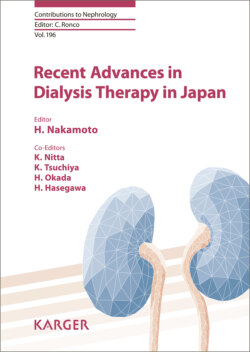Читать книгу Recent Advances in Dialysis Therapy in Japan - Группа авторов - Страница 7
На сайте Литреса книга снята с продажи.
Preface
ОглавлениеThe 62nd Annual Meeting of The Japanese Society for Dialysis Therapy, held in June 2017 in Yokohama, Japan, brought together 22,412 participants from Japan and overseas for special lectures, educational lectures, symposia, and workshops to discuss the theme “Time for Transformation: A Bright Future for Dialysis Therapy.”
As a result of the statistical survey at the end of 2016, The Overview of Regular Dialysis, 329,609 patients were under dialysis, an increase of 4,623 patients compared to end of 2015. This number is the third largest number in the world next to the United States and China. However, the number of peritoneal dialysis (PD) patients was only 9,021, 2.7% of all dialysis patients. The number of PD patients has been declining since 1998. More than 95% of these patients undergo in-center hemodialysis (HD), and very few ESRD patients undergo PD and kidney transplantation. This in-center excessive bias of HD is a feature of dialysis therapy in Japan. Another important issue facing Japan is the aging of dialysis patients. The average age of patients introduced to dialysis in 2016 was 69.4 years, respectively, rising by 0.2 years from 2015. The average age of males was 68.57 years, and that of females was 71.19 years, an increase of 0.20 and 0.24 years, respectively, as compared with 2015. The average age of maintenance dialysis patients was 68.15 years, which increased by 0.29 years compared with the previous year. The average age of males was 67.34 years, an increase of 0.27 years; the average age of females was 69.61 years, an increase of 0.33 years. Both males and females, 65–69 years old, represented the highest proportions. This increase in average age is largely due to the aging population. In addition, the effect of treatment of renal failure patients in the preservation period is good in Japan. The rapid increase in the number of dialysis patients does not only concern Japan. It is a major global problem in the world including Asia, Africa, Europe, and America.
For over 40 years, dialysis therapy has been used to prolong the lives of patients with endstage renal failure. Japan is now widely regarded as a world leader in dialysis, and we owe much to the efforts of many highly skilled predecessors. Although the rate of increase in the number of dialysis patients is starting to level off, our generation of practitioners still has important questions to address in today’s world of major transformation; for example, how can we best deal with increasing medical costs as the population ages, manage end-of-life care, and train all the practitioners involved in dialysis care? Based on the current state of dialysis therapy in Japan, The 62nd Annual Meeting of Japanese Society for Dialysis Therapy was held at the Pacifico Yokohama in Yokohama for 3 days from 16th to 18th of June 2017. The theme of this meeting was “Dialysis Therapy in Japan Came to the Transition Period – To Build a Bright Future.” The 62nd Annual Meeting offered our diverse membership, including nephrologists, urologist, physicians, nurses, clinical engineers, pharmacists, and nutritionists, opportunities to discuss the reality we are facing and look towards transformations that can help make an even better future. This important comprehensive publication presents selected articles from the meeting as well as some invited articles from our membership.
We selected 37 interesting topics from the conference presentations and decided to prepare a collection of records as papers. The 37 articles, organized into 4 chapters, discuss recent advances in dialysis therapy in Japan.
Chapter 1 concerns recent knowledge about dialysis patients, such as causes, risk factors, disease associations, and possible implications for management of dialysis patients, In addition, we must consider important topics, including risk of sudden cardiac death in dialysis patients, the role of asymptomatic cerebral small-vessel disease in future onset of stroke, chronic kidney disease (CKD) as a risk factor for cognitive impairment, the importance of physiological erythropoiesis in the treatment of CKD-associated anemia, and current issues to consider for combined therapy with PD and HD, which is becoming widespread in Japan.
Chapter 2 examines recent progress made in HD treatment. Among the 8 articles presented, we learn more about management approaches, such as total renal care for ESRD, intermittent infusion hemodiafiltration, and levocarnitine administration, as well as how to manage physical frailty and hepatitis C virus infection.
Chapter 3 focuses on advances in PD. The 10 articles cover a broad range of areas, starting with an overview of PD in Japan and moving through discussions of PD in children and the elderly to considerations in translational research and home PD.
Chapter 4 concludes the publication with 9 articles on recent advances in apheresis and current trends in practice, among other topics. For example, we explore current practices and trends in apheresis, pediatric renal replacement therapy, and home HD management.
I hope that the collection of The 62nd Annual Meeting of The Society for Dialysis Therapy will be useful for the future of progress of dialysis therapy in the world.
Hidetomo Nakamoto, Saitama
Congress Chair
62nd Annual Meeting of The Japanese
Society for Dialysis Therapy
